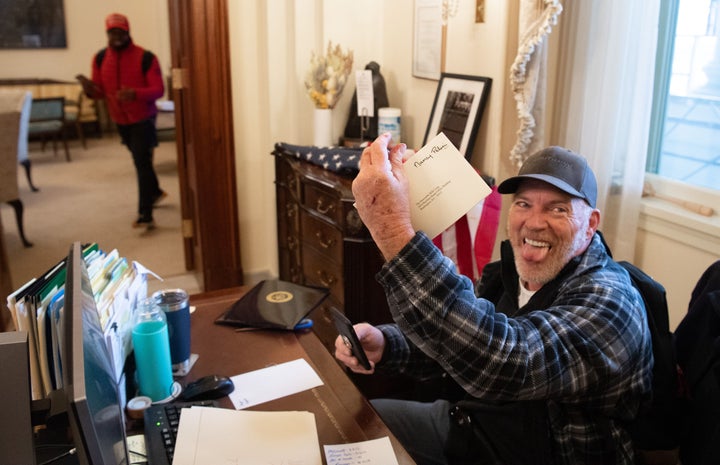Living in Washington, DC, I have been lucky enough to spend a lot of time at the Capitol with my children, starting from when they were very young. One of my sweet, feisty daughters has complex medical needs and multiple disabilities. She started visiting the Capitol with me when she was just four years old to advocate for access to the health care she will need for the rest of her life.
Because assaults on civil rights and the rights of disabled people have not stopped, we have not stopped our advocacy, either.
Every time I visit the Capitol, I am in awe of its big, beautiful dome stretching into the sky, symbolising the strength and endurance of American democracy. I am equally awed by what normally appears to be one of the most efficient security operations in the world.
My family’s visits to the Capitol over the years have increased in frequency as Trump’s attacks on health care and civil rights have intensified. During every visit, my young daughter in a wheelchair is subjected to intense security searches. She is often required to get out of her wheelchair to be searched while her wheelchair is inspected thoroughly.
My toddler son was once driven to the point of a meltdown when a Capitol Police officer took his snack cup out of my bag for closer inspection because of its odd shape on the x-ray machine. My toddler’s snack was inspected by a Capitol Police officer for long enough that my son thought he would never get his snack back.
While attending press conferences in restricted areas in the Capitol as part of my advocacy work, I have had to provide my name in advance to be cleared to attend. I am required to go through security and provide ID to enter. Even then, I am required to have an escort until I reach my destination. I am required to wear a badge that lists the date and the specific room I have permission to be in. If I leave the immediate area of that room to use the bathroom or try to calm an anxious child, I will be stopped within seconds to ask where I am going.

Many of my friends have similar stories. A friend’s eight-year-old daughter is Deaf. Her cochlear implants mean she cannot go through a metal detector. When she visits the Capitol, she often needs to wait more than 30 minutes to be let in until a female officer can be found to thoroughly pat her down while her mother holds her.
Another friend was escorted out of the Capitol with her baby son in his stroller for leaving a Post-it note on a senator’s door while Congress was out for recess. A member of Congress was offended that the note she left suggested that the Senate was not doing enough to curb gun violence and requested that the Capitol Police remove them from the building.
Security is so tight around the door leading to the Senate Chamber that when a friend who had clearance to be in that part of the building held up her phone to take a photo of herself and her infant son with their senator, Capitol Police immediately approached her and told her that she would have to leave if she did not put her phone away.
Anyone who actually goes into the Senate Chamber has to surrender their phone and go through a second security point before being let in. Once inside, security is even tighter. Actor and activist Alyssa Milano had a clipboard confiscated during the hearings to confirm Brett Kavanaugh’s nomination to the Supreme Court because it had a sticker on it that read, “I Believe Survivors.” A friend’s preteen son lost his pencil and paper because no doodling is allowed, either.
And of course, there are microaggressions against people of colour. Capitol Police once told a well-known health care and disability rights activist that she had to take a “Save Medicaid” button off of her daughter’s wheelchair because it was a political slogan. While rules are strict within the Capitol, political slogans on buttons and T-shirts are not just permitted but common. She complied because she did not want to get kicked out, but other advocates noted the disparity in treatment. I’m sure she is not the only person of colour to have been treated more harshly than white activists inside the Capitol.
“The treatment my friends and I experience at the Capitol as advocates and activists stands in stark contrast with the way the Proud Boys and other rioters were treated on Jan. 6.”
I have been in the Capitol when disabled protesters were literally dragged out of their wheelchairs and swiftly arrested for protesting after the Capitol Police deftly blocked the hallway where they had gathered. My children asked why so many people in wheelchairs were handcuffed and guarded so heavily when they would not be able to hurt anyone or run away. I had no answers for them.
The treatment my friends and I experience at the Capitol as advocates and activists stands in stark contrast with the way the Proud Boys and other rioters were treated on 6 January. Whereas I have come to expect metal detectors and strict enforcement of the rules that have kept the Capitol safe for over 200 years, the Capitol Police opened barricades for the rioters and waved them in despite their display of such overt symbols of hate as the Confederate flag and a “Camp Auschwitz” shirt.
This insurrection mounted by domestic terrorists at the urging of a sitting president was planned well in advance. Plans to “Storm the Capitol” were discussed on social media. Trump himself tweeted, “Big protest on January 6th. Be there, will be wild.”
As we all saw, it was indeed wild. As the insurrection unfolded, the Capitol Police seemed to be sparse and taken by surprise. In a city known for mass protests, a city that knows how to prepare, this complete lack of security was unthinkable.
This was no ordinary protest, either. The insurrectionists showed up with bombs and assault weapons. Their plans included not just stopping the certification of an election that was conducted freely and fairly without any evidence of fraud, but to do so by force. Even more concerning, the insurrection was planned for a day when both Vice President Mike Pence and Speaker of the House Nancy Pelosi, the first and second people in line for succession to the presidency, were present in the Capitol, and there were explicit calls to “Hang Mike Pence.”
I have lived in DC for over 20 years and have never been afraid of going to protest or just being near one. This was different, in no small part because of the way the rioters seemed to be treated like honoured guests, posing for selfies on the Senate dais and parading through the halls of the House with the speaker’s lectern.
It’s hard to reconcile these images with my own experiences of entering the Capitol under tight security. For more than 200 years, the Capitol has been a solemn place of democracy. I do not always like what happens in the Capitol, but its halls have always been a place for serious reflection and action. They have always been secure.
On 6 January, the lacklustre response to rioting Trump supporters put democracy in peril, and, at times, the Capitol looked more like the scene of a frat party than the seat of the United States Congress.
To those of us who live in D.C., another contrast was blatant. Just months earlier, when Black Lives Matter protests filled the streets of the city demanding justice for George Floyd, Breonna Taylor and the countless other Black lives lost to senseless police violence, we saw how D.C. can quickly mobilise a large and terrifying force when it has the will to do so.
For the Black Lives Matter protests over the summer, the National Guard was activated almost immediately. One of the most chilling sights from that time was the heavily armed, unmarked federal agents in military uniforms throughout the city.
When it came to Black Lives Matter protests, no show of power and might was too much. Law enforcement did not hesitate to use force or make arrests. Most notably, the National Guard tear-gassed a mostly Black, completely peaceful gathering in Lafayette Park across from the White House for the sole purpose of allowing Trump to take a photo of himself in front of a church holding a Bible backward.
This disparity in the way white supremacist terrorists and Black Lives Matter protesters were treated was blatant enough to be noted by President-elect Joe Biden when he said that “no one can tell me that if that had been a group of Black Lives Matter protesting yesterday, they wouldn’t have been treated very, very differently than the mob of thugs that stormed the Capitol.”
Yet I do not expect anything to change. The Proud Boys have been emboldened by the reception they got in Washington on Jan. 6, which fell just short of a warm welcome. White extremist groups are openly planning another attack the week of Jan. 20 when President-elect Joe Biden and Vice President-elect Kamala Harris will be sworn in to office, and The FBI has warned of plans for armed protests at all 50 state capitals. Across the city, neighbours are urging one another to take down Airbnb listings and to remove Black Lives Matter signs and rainbow flags from their windows for fear of being targeted.
It could not be clearer that there are different rules for domestic terrorists who are white and Black Lives Matter activists and their allies. Even the regular rules that apply to ordinary activists and advocates like me were swept aside. There has been no clear rebuke of the president’s role in inciting this insurrection and the deaths it caused, no sanction for shaking our democracy to its core.
On 6 January, there was a choice not to be prepared, to go easy on the white domestic terrorists who infiltrated the Capitol. There can be no clearer sign of who we are as a nation.
This article first appeared on HuffPost Personal
Have a compelling personal story you want to tell? Find out what we’re looking for here, and pitch us on ukpersonal@huffpost.com

